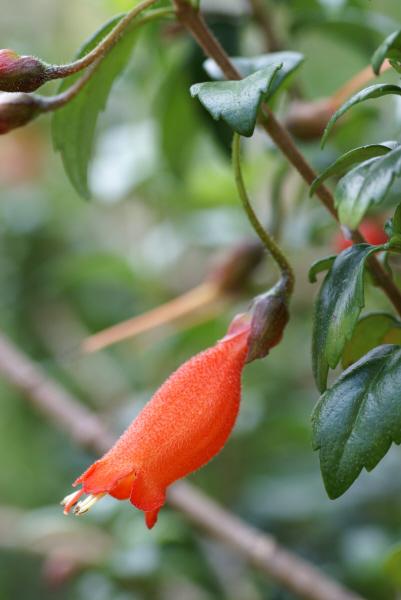Mitraria coccinea
mitre flower
A woody-based, creeping climber with small, oval, toothed, evergreen leaves. Tubular, red-orange flowers, up to 5cm long, are borne in late spring and early summer followed by fruit in the form of a fleshy capsule

Buy this plant
Size
Ultimate height
1.5–2.5 metresTime to ultimate height
10–20 yearsUltimate spread
1.5–2.5 metresGrowing conditions
Moisture
Moist but well–drainedpH
AcidColour & scent
| Stem | Flower | Foliage | Fruit | |
| Spring | Orange Red | Green | ||
|---|---|---|---|---|
| Summer | Orange Red | Green | Green Red | |
| Autumn | Green | |||
| Winter | Green |
Position
- Full shade
- Partial shade
Aspect
North–facing or West–facing or East–facing
Exposure
Sheltered Hardiness
H3Botanical details
- Family
- Gesneriaceae
- Native to GB / Ireland
- No
- Foliage
- Evergreen
- Habit
- Climbing
- Genus
Mitraria is a genus with a single species (monotypic) originating from Chile
- Name status
Correct
- Plant range
- Chile, Argentina
How to grow
Cultivation
Can be grown as a climber or a standalone shrub. Considered half-hardy; enjoys shelter and a semi-shaded position in naturally peaty, acidic soil
Propagation
Propagate by stem cuttings in summer or propagate by seed sown with bottom heat in summer
Suggested planting locations and garden types
- City and courtyard gardens
- Wall side borders
Pruning
Trim if outgrowing site
Pests
Generally pest-free
Diseases
Generally disease-free
Love gardening
Sign up to receive regular gardening tips, inspiration, offers and more
View our Privacy Policy
Get involved
The Royal Horticultural Society is the UK’s leading gardening charity. We aim to enrich everyone’s life through plants, and make the UK a greener and more beautiful place.